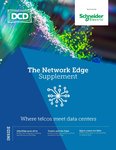Now that we are past Covid-19, school districts worldwide have had the opportunity to prioritize the advancement of their digitization strategies by adopting new learning tools and upgrading their infrastructure. Additionally, it has been crucial for them to ensure that their IT teams are equipped with the necessary tools and training to effectively support the digitization process.
During the height of the pandemic, school district IT departments had to quickly revisit their data center and Edge computing strategies to provide system resiliency and high availability and support hybrid learning environments. These environments combine online and on-site learning at the K-12 and higher education levels.
The job isn’t done yet. Digital transformation in education will continue for the foreseeable future. It is now common for students in a classroom to carry an endpoint device, like a laptop, tablet, or smartphone. Those devices and new classroom technology, such as touchscreen displays, will enable further digitization as educators continue relying on digital solutions in the classroom.
Meanwhile, demand for data keeps increasing, further straining IT infrastructure and potentially causing downtime, connectivity, or latency issues. As a result, schools still need to bolster their IT infrastructure as demand increases.
Growth of AR and VR applications in education
Newer applications will continue to increase the demand for additional local data processing. For example, in the next five years, augmented reality (AR) and virtual reality (VR) applications will likely become common in schools around the world. Teachers have started leveraging the metaverse as a learning platform. The metaverse combines AR, VR, and the internet to provide an immersive, collaborative environment.
Some schools already use AR and VR for field trips that students can take without leaving their desks. In addition, immersive online competitions are starting to gain popularity. And it shouldn’t be long before eSports, which use video games for multiplayer competitions, become a common extracurricular activity.
These emerging digital tools will be woven into existing hybrid environments, and as schools proceed with digital transformation, they will require additional infrastructure, security, and power protection to support new applications and equipment. Some legacy equipment may need to be replaced to accommodate new, data-intensive requirements. And along with that, schools are likely to also need upgrades in cooling, ventilation and power management systems.
Investment in digital tools still growing
Education investments in digital tools such as language apps, virtual tutoring, and online learning software are increasing around the globe. These investments reached $18.66 billion (USD) in 2019, and the overall market for online education is projected to reach $350 billion by 2025, as noted by the World Economic Forum.
How schools and universities access funds differs from one region to another. For instance, in the US, K-12 schools can qualify for the E-Rate Connectivity Fund, which makes high-speed internet affordable to schools and libraries for online education and library services. Schools in EU countries can apply for funding by responding to calls for proposals at the national and regional levels.
As schools digitize, bandwidth and systems availability will remain a priority, creating IT staffing challenges. Many districts lack enough IT staff to maintain and monitor the additional infrastructure and software that support new digital tools. This adds pressure on existing staff to meet educators’ and students’ needs. IT teams can address this challenge with remote monitoring tools and services to run their data centers, edge computing applications, and communications networks.
Addressing data hungry applications
Educational institutions should consider investing in advanced networking equipment to handle a potential explosion of rich media being transferred across their networks. In addition, they should review their infrastructure, power, and cooling device needs to help maintain network uptime.
Finally, to help monitor and manage distributed infrastructure, IT teams can turn to remote monitoring to enable educators, students, administrators, and IT staff to connect to school networks both on-site and from home.
Remote visibility into server room power, cooling, computer equipment, and wiring closet networking equipment enables systems administrators to monitor performance and identify equipment anomalies.
In addition, uninterruptible power supplies (UPSs) help maintain systems’ availability by providing transitional power during outages. These UPSs allow administrators to remotely reboot systems when necessary.
Worth considering for schools are small, lightweight UPS models designed for Edge computing environments and micro data centers. For example, the APC Smart-UPS Ultra is 30 percent smaller, 50 percent lighter, and delivers one and a half times more power than previous models. This makes them easier to deploy in tighter spaces with higher compute requirements.
Resources to bolster IT infrastructure
Learn more about how educators and their IT staff can be better prepared to accommodate expanded online learning environments and data intensive applications. Also, discover how the Smart-UPS Ultra can increase IT infrastructure resiliency and keep learning applications up and running even when the power is out.
More from Schneider Electric
-

DCD>Talks IT enabled future with Carsten Baumann, Schneider Electric
Tune into this DCD>Talk where we discuss the IT enabled future in healthcare, manufacturing and higher education, with Carsten Baumann, Schneider Electric
-

The Network Edge Supplement
Where telcos meet data centers
-

All eyes on the Edge
Scaling infrastructure at the Edge whilst reducing the carbon footprint of distributed IT


